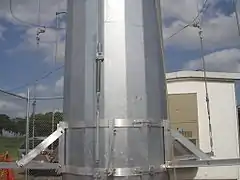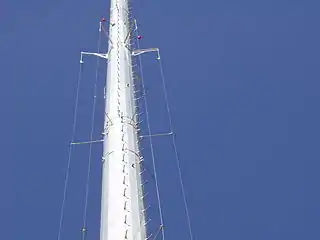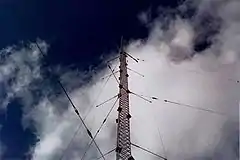Folded unipole antenna
The folded unipole antenna is a type of monopole antenna; it consists of a vertical metal rod or mast mounted over a conductive surface called a ground plane. The mast is surrounded by a "skirt" of vertical wires electrically attached to the top of the mast. The skirt wires are connected by a metal ring at the bottom and the feed line is connected between the bottom of the wires and ground.
It has seen much use for medium wave (AM broadcast) stations in the United States, and other countries as well. When an AM station (mediumwave, long antennas) shares a tower with FM transmitters (VHF, short antennas), the folded-unipole is often a good choice. Since the base of the tower connects to the ground system, the transmission lines to any antennas mounted on the tower can run up the side of the tower without requiring isolation, even though the tower itself carries mediumwave current.

Invention
The folded unipole antenna was first devised for broadcast use by John H. Mullaney, an American radio broadcast pioneer, and consulting engineer. It was designed to solve some difficult problems with existing medium wave (MW), frequency modulation (FM), and amplitude modulation (AM) broadcast antenna installations.
Typical installation
A typical AM broadcast antenna is a series-fed monopole antenna above a ground system. The ground system normally comprises 120 buried copper or phosphor bronze radial wires at least one-quarter wavelength long and a ground-screen in the immediate vicinity of the tower. All the ground system components are bonded together, usually by brazing or using coin silver solder to minimize corrosion. These antennas have insulated bases. If required, insulated guy wires are used. Radio frequency power is fed across the base insulator between the ground system and the tower itself. In the US, the Federal Communications Commission (FCC) required that the transmitter power measurements for a single series-fed tower calculated at this feed point as the current squared multiplied by the resistive part of the feed-point impedance.

Electrically short monopole antennas have low resistance and high reactance. Longer antennas may have impedances that are more advantageous unless the electrical height exceeds about 5⁄8 of a wavelength. In any case, an electrical network at the base of the tower matches the antenna to its transmission line. If the tower is very short, it will have its capacitive reactance tuned out by this matching network. This network and tower combination often results in a narrow bandwidth, severely limiting the audio frequency fidelity of the radio station. Electrically short antenna systems have relatively small apertures and high losses. The cause of these losses is related to the relatively low radiation resistance of an electrically short radiator with respect to the RF resistance of the ground system and matching networks, all of which are in series with the antenna current.

Using a folded unipole will increase the bandwidth of electrically short antennas because its feed-point comprises less reactance that needs to be tuned out. There are additional performance claims made by some when the resulting antenna allows most all of the reactance to be removed with a tuning-short, rather than electrical components in a tuning network.
The picture below shows another folded unipole antenna constructed from an existing series fed monopole. This antenna has only three vertical wires comprising the "skirt".

One usually constructs the folded-unipole by modifying an existing monopole antenna. First one connects the base of the tower directly to the ground system by shorting out the base insulator. Then a series of vertical wires – typically four to eight – are installed from an attachment near the top of the tower; these wires surround the tower and are called a "skirt". The skirt wires are kept a constant distance from the tower by insulated structural members and attached together near the bottom of the tower. The resulting skirt connects at the tower top and remains insulated throughout its entire length. The antenna feed connects between the ground and the skirt wires where they join at or near the bottom of the tower.
Performance comparisons
When a well-made folded-unipole replaces a decrepit antenna or one with a poor design, there will of course be an improvement in performance. However, direct comparisons between folded unipoles and more conventional vertical antennas of the same height, all well-made, show essentially no difference in performance either for better or worse.[1]
Most commonly, folded-unipole designs were used to replace a shunt-fed antenna – a different-design broadcast antenna that also has a grounded base. A “shunt-fed” (or “slant-wire”) antenna comprises a grounded tower with the top of a sloping single-wire feed-line attached at a point on the mast that results in an approximate match to the impedance desired at the other end of the sloping feed-wire.[lower-alpha 1][lower-alpha 2] When the folded-unipole antenna replaced the slant-wire fed antenna, a marked improvement of performance often occurred. This gave rise to the notion that folded-unipole antennas had power gains or other wonderful characteristics not supported by radio engineering calculations.
Sites of ground-mounted monopole antennas require landscape maintenance: Keeping weeds and grass covering the antenna's ground-plane wiring as short as possible, since weeds will dissipate radio frequency power, severely reducing antenna efficiency. Folded-unipole antenna sites are alleged to be less affected by disturbances near the ground that cause attenuation in other monopole antenna designs, but measurements show no such advantage.[1][3]
Some claims have been made that other ground-system losses are reduced for the folded unipole antenna. However, such claims do not consider the general principle that for the same conditions, the total displacement current in the ground system around a folded unipole is essentially identical to a conventional series-fed monopole using the same ground system. Therefore it is no surprise that ground losses for the two radiator configurations are very similar.[3] Experiments by Rackley, Cox, Moser & King (1996) have shown that claims of superior folded-unipole performance are incorrect.[1]
A possible improvement over the basic folded-unipole antenna is the “self resonant” unipole antenna, described in U.S. Patent 6,133,890.[lower-alpha 3] Another possible improvement to the folded-unipole is described in U.S. Patent 4,658,266.
See also
Footnotes
- The point on the mast is almost always chosen to be slightly inductive, so that a series capacitor (low-loss) can tune out the remaining reactance on the feed-line.[2]
- When the feed wire drops parallel to the radiating element, instead of sloping away, the configuration is called a gamma match or gamma feed.[2]
- U.S. Patent 6,133,890 abstract: A self-resonant vertically polarized folded unipole antenna for long wave (LW) [and] medium wave (MW) broadcasting, and for the 160 meter amateur radio band with a grounded tower connected to radially descending fold wires terminated near the base of the tower in an open polygonal ring, possibly a C-ring with a reactive load in series with this ring. This reactance cancels the reactive component of the antenna input impedance causing the input impedance to appear resistive at the feed point. This leads to outstanding linearity and bandwidth up to and possibly exceeding plus or minus 16 kHz, sometimes exceeding plus and minus 20 kHz.
References
- Rackley, Ronald D.; Cox, Bobby L.; Moser, James R.; King, Tom F. (16 April 1996). An efficiency comparison: AM/medium wave series-fed vs. skirt-fed radiators (PDF). National Association of Broadcasters Engineering Conference. Las Vegas, NV. Archived from the original (PDF) on 29 September 2011. Retrieved 18 July 2011.
- ARRL Antenna Book. Newington, CT: American Radio Relay League.
- Cox, Bobby L.; Moser, James R. (2002). "Folded-unipole antenna study" (PDF). Archived from the original (PDF) on 14 July 2006. Retrieved 10 September 2006.
- Raines, Jeremy K. (2007). Folded Unipole Antennas: Theory and Applications. New York, NY: McGraw-Hill.
- Raines, Jeremy K. (January 2009). "Simple formulas for folded antennas" (PDF). Microwave Journal (electronic edition). Archived from the original (PDF) on 2009-02-05.
External links
- "Mullaney Engineering, Inc". Mullengr.com. Retrieved 2017-01-28.
- "Lightning Protection Systems". Nott Ltd. Retrieved 2017-01-28.
- "Consulting: electrical engineering, electromagnetic fields, radiating and scattering systems". Raines Engineering. Retrieved 2017-01-28.